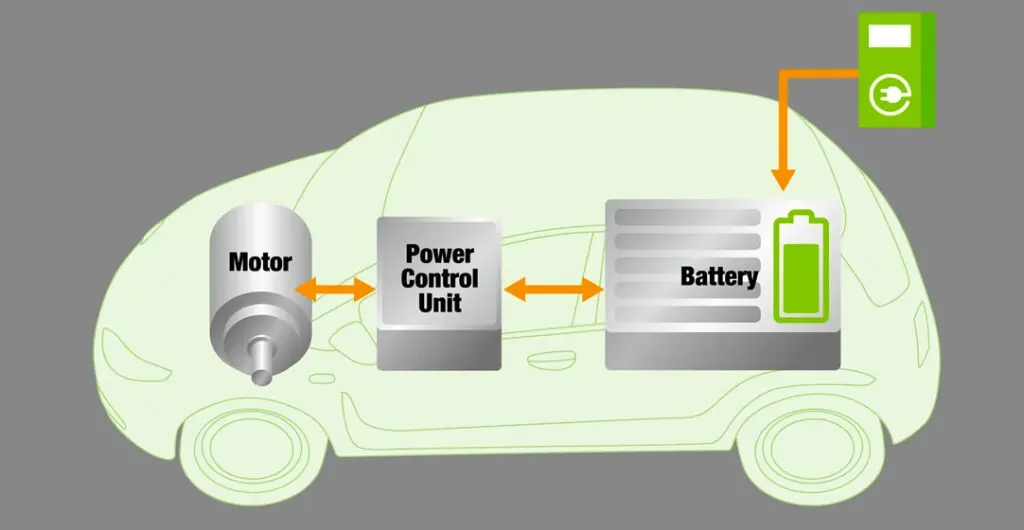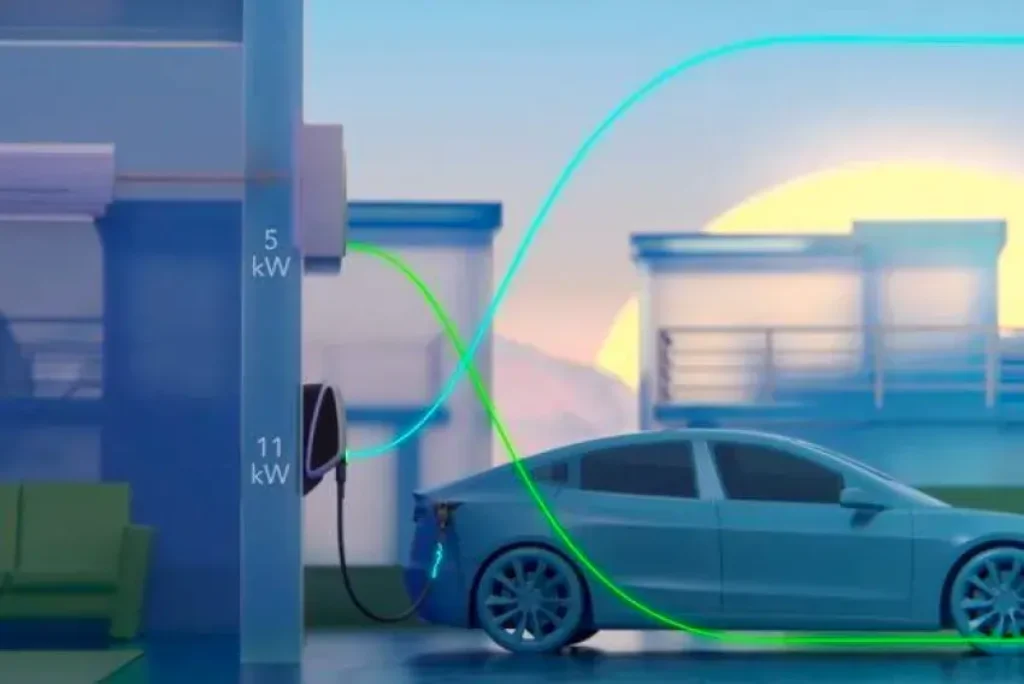
EV Motor Maintenance has become a significant aspect of the rising popularity of electric vehicles (EVs) in India. One of the key advantages of EVs is their decreased maintenance requirements when compared to traditional gasoline engines.
But how much maintenance does the electric motor actually require? This guide examines EV motor maintenance needs, costs, and best practices.
Table of Contents
Overview of EV Motor Maintenance/Technology
The majority of contemporary electric vehicles (EVs) employ an AC induction motor for propulsion. These AC induction motors feature a straightforward design, making them a suitable choice for EV motor maintenance.
- A rotor contains conductors like aluminum bars that spin inside the motor
- Surrounding the rotor is a stator comprised of coiled copper wire
Power from the battery flows into the stator coils, creating a rotating magnetic field. This induces currents in the rotor, generating torque that turns the motor shaft and wheels.
Benefits of AC induction motors:
- Simple, rugged, and compact design
- Don’t need regular maintenance like oil changes
- Generate maximum torque from 0 rpm for strong acceleration
- Require no brushes or commutation
- Low noise operation
However, they still require some periodic maintenance for optimal performance and longevity.
Routine Maintenance Items
EV Motor Maintenance, while generally low, does involve some regularly recommended maintenance:
Tire Rotation
Tire rotation helps distribute wear evenly across the tires to maximize their service life. Follow the rotation interval in your owner’s manual, usually around every 6,000-10,000 miles.
Wheel Alignment
Misalignment causes uneven tire wear. Alignment should be checked any time new tires are installed or pulling is noticed during driving. Most EVs need alignment every 20,000-30,000 miles.
Cabin Air Filter Replacement
A clean cabin air filter improves HVAC performance and prevents musty smells. Replace it per the maintenance schedule, typically every 20,000-30,000 miles.
Brake Inspection
EVs use regenerative braking to charge the battery. But friction brakes are still needed as a backup. Inspect brake pad thickness and rotor condition each service visit.
Tire Condition Inspection
Inspect tires for abnormal or uneven wear. Look for cracks, bulges, cuts, and embedded objects. Check tread depth monthly and before long trips.
Washer Fluid Top Off
Check the washer fluid level each visit and top off with the recommended solvent mix to clean the windshield and headlights.
Battery Coolant
For EV Motor Maintenance, if the battery incorporates a liquid cooling system, make sure to examine the coolant level and its condition according to the prescribed maintenance schedule.
Remember to replace it periodically, similar to the maintenance routine for engine coolant.
HVAC Air Filter
Replace the HVAC air filter as recommended, often in tandem with the cabin air filter. A clogged filter reduces airflow.
Wiper Blade Replacement
Inspect wiper blades frequently for cracking and change them about once a year or when performance deteriorates.
Less Frequent Maintenance

A few additional maintenance items may arise every few years:
Brake Fluid Flush
Moisture accumulation in brake fluid reduces braking performance. Flush the fluid every 2-3 years to restore optimal viscosity and boiling point.
Transmission Fluid
EVs with single-speed gearboxes require no transmission maintenance. EVs with multi-speed gearboxes need occasional fluid changes, around every 50,000 miles.
Coolant Flush
The motor and battery may share a glycol-based coolant loop that needs draining and refilling every 3-5 years to remove accumulated contaminants.
Suspension Inspection
Inspect shocks/struts, ball joints, tie rods, sway bar links, and other suspension components periodically for tightness and wear. Replace if heavily worn.
Wheel Bearing Repack
Wheel bearings allow smooth, low-friction rotation. Repack with fresh grease occasionally, usually around 6-8 years unless wear is heard.
Brake Fluid Flush
Moisture accumulation in brake fluid reduces braking performance. Flush the fluid every 2-3 years to restore optimal viscosity and boiling point.
Cabin Air Filter Replacement
Replace the cabin air filter periodically as recommended, often coinciding with the HVAC air filter replacement. A clogged filter reduces HVAC performance.
Read This: Exploring EV Operating Costs: Which Electric Vehicle Models are the Most Affordable?
Motor Maintenance Costs

EV motor maintenance costs are quite minimal compared to gas or diesel vehicle engine maintenance. Some example cost comparisons in India for a typical hatchback:
| Service Item | EV | Petrol | Diesel |
|---|---|---|---|
| Oil Change | ₹0 | ₹1,500-₹2,500 | ₹1,500-₹2,500 |
| Air Filter | ₹500 | ₹500 | ₹500 |
| Spark Plugs | ₹0 | ₹2,000 | ₹0 |
| Fuel Injector Cleaning | ₹0 | ₹3,000 | ₹3,000 |
| Transmission Service | ₹2,500 | ₹5,000 | ₹7,500 |
| Coolant Change | ₹1,500 | ₹2,000 | ₹2,000 |
| Total Yearly (Estimated) | ₹6,000 | ₹18,000 | ₹21,000 |
Beyond lower maintenance costs, EVs also save substantially on fuel costs compared to petrol or diesel vehicles. The only added EV expense is battery degradation and eventual replacement.
DIY Maintenance Tips
Many EV maintenance tasks can be performed yourself in your garage or driveway:
- Tire rotation – Rotate tires according to service schedule spec
- Tire inflation – Check pressures monthly with a quality gauge
- Washer fluid top-off – Refill the washer reservoir with a solvent mix
- Wiper inspection – Replace any torn, cracked, or streaking blades
- Light inspection – Replace any burnt-out headlights, turn signals, etc., promptly
- Battery charging – Charge battery back to 100% after long trips
- Cabin air filter – Replace when dirty; avoid knocking debris into HVAC intake
- Vacuuming – Clean the interior regularly to avoid stains or damage
- Glass cleaning – Keep windows and mirrors clean for maximum visibility
Refer to your owner’s manual for any specifics on safely performing these DIY maintenance tasks. Other items like alignment, brakes, and coolant flushes require automotive skills and specialty tools.
Signs of Motor Problems in EVs
While robustly built, monitor for these signs of potential issues with your EV’s motor:
- Loud whining noise, especially at higher speeds
- High-pitched squealing or screeching sounds
- Clunking sounds when accelerating or decelerating
- Vibration or shaking in the steering wheel
- Loss of power
- Reduced electric range between charges
- Motor temperature warning light activates
Schedule service promptly if you notice any of these symptoms. Even minor problems like wheel misalignment can exacerbate motor wear if left unchecked.
Extending Electric Motor Lifetime

To enhance the longevity of your EV motor, conscientious driving, and diligent EV motor maintenance are essential practices:
- Accelerate and decelerate gradually – avoid jackrabbit starts
- Bring the vehicle to a full stop before shifting between D/R modes
- When safe, coast down in advance of stops rather than braking heavily
- Stick to moderate speeds on the highway; avoid sustained high rpm operation
- Don’t lug the motor; shift to a lower gear to get back into peak torque band
- Make sure tire pressures, alignment, etc., are maintained to spec to reduce strain
- Follow the maintenance schedule in your owner’s manual
- Fix even minor issues early before they cascade into larger problems
A well-cared-for electric motor can easily achieve 200,000+ miles of reliable service life. Some fleet vehicles accumulate over 300,000 miles on their original motors.
When Does an Electric Motor Need Replacement?
Typical scenarios when an EV motor requires major service or replacement:
- Insulation breakdown causing arcing and short circuits between windings
- Worn bearings allow excessive rotor wobble
- Failed electronics like current sensors, power transistors, etc.
- Cracked rotor bar or demagnetization
- Crash damage
- Advanced corrosion in windings or housing from water ingress
- Excessive high mileage wear (200k+ miles)
EV Motor Maintenance unless a manufacturing defect is present, EV motors can effortlessly reach 150,000+ miles before requiring significant service, with the potential to surpass 300,000 miles when driven and maintained with care.
Electric Motor Failure Risks
Although uncommon, a minority of electric vehicle (EV) motors may encounter premature failure. Factors contributing to this risk encompass aspects related to EV Motor Maintenance.
- Manufacturing defects – substandard materials or workmanship
- Software bugs – errors in motor control algorithms
- Design flaws – inadequate cooling, undersized bearings, etc.
- Component failures – faulty sensors, power electronics, etc.
- Assembly issues – loose fasteners, misalignments
- Water intrusion – corrosion of copper windings
- Rodent damage – chewing of insulation
- Crash damage
- Modifications – performance tuning, lifting, oversized wheels, etc.
Sticking with a major EV brand and avoiding modifications can minimize the chances of early motor troubles.
Diagnosing Motor Problems
If abnormal symptoms arise, work with a qualified EV technician to diagnose the issue. They can:
- Retrieve diagnostic codes from the motor controller software
- Perform voltage, current, and resistance tests on motor windings
- Check the rotor position sensor and encoder operation
- Examine stator windings for discoloration or cracked insulation
- Evaluate noise signature and vibration patterns
- Assess bearing wear via play or friction
- Measure back EMF behavior and waveform
This pinpoints whether the issue stems from motor windings, bearings, sensors, power electronics, or elsewhere.
Electric Motor Repair or Remanufacture
For motors with simple issues like failed bearings, a repair may be feasible. Bearings can be replaced, and the rotor balanced.
More extensive internal issues often require complete remanufacturing. The motor is fully disassembled, and components like rotors, stators, housings, and sometimes electronics are replaced. This returns the motor to like-new condition.
When it comes to EV Motor Maintenance, remanufacturing proves to be a cost-effective option primarily for larger electric vehicle motors.
Conversely, when smaller motors encounter problems, opting for a brand-new replacement unit is frequently the preferred solution.
Conclusion
EV Motor Maintenance Compared to a similar gas engine, maintaining an electric vehicle motor demands significantly less time, expense, and effort.
Apart from routine tire and brake upkeep, electric vehicles require minimal periodic maintenance throughout their initial 100,000 miles or more of service.
EV Motor Maintenance is hardly a concern for most electric vehicle owners, as long as they drive attentively and take good care of their vehicles.
With proper attention and care, the motor should easily endure the vehicle’s entire lifespan. So, for most EV owners, the mantra is simple: charge up and enjoy the ride.







